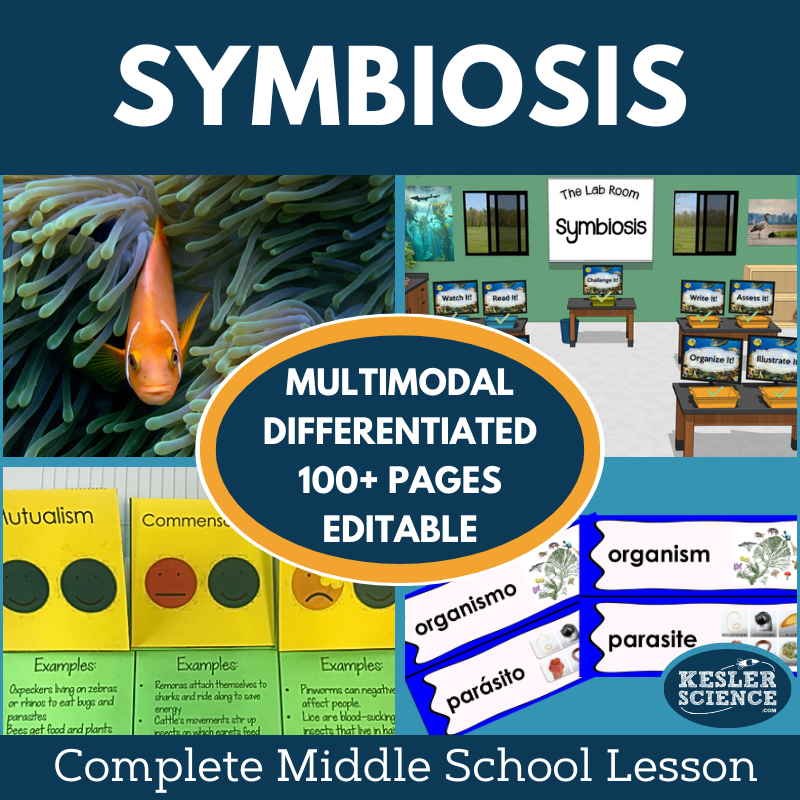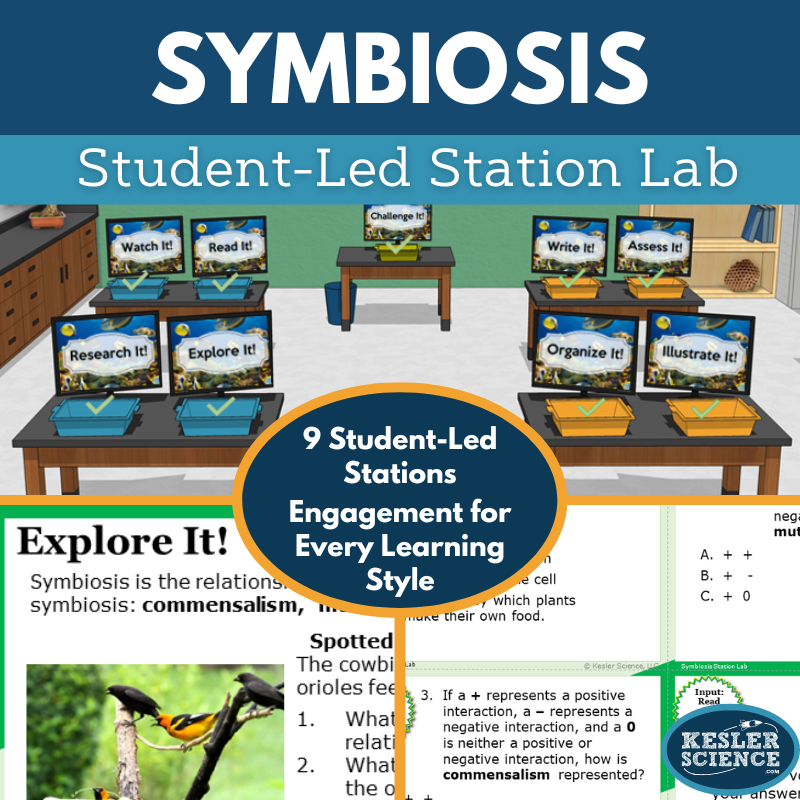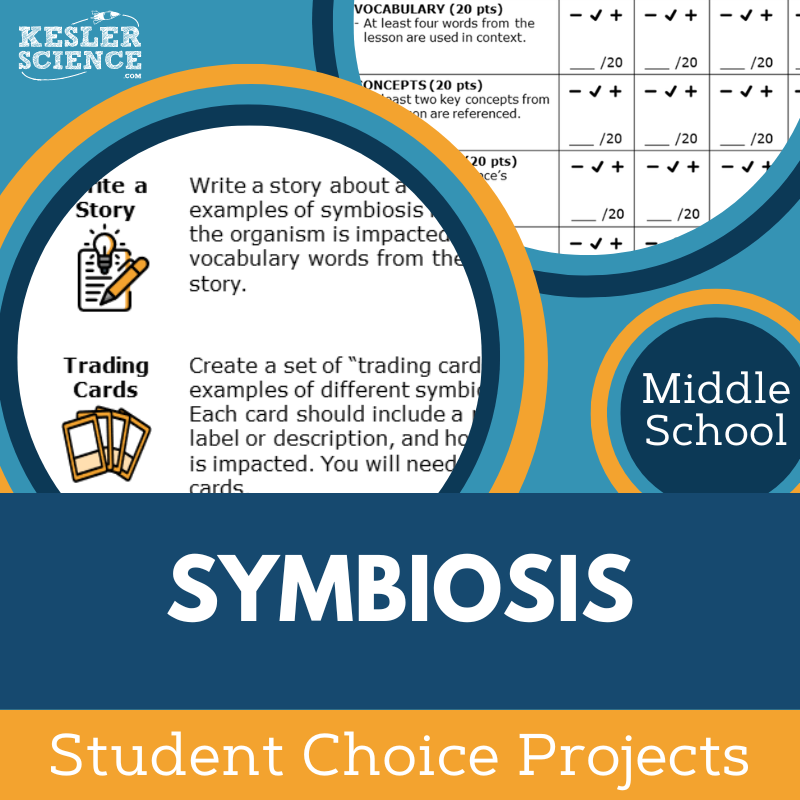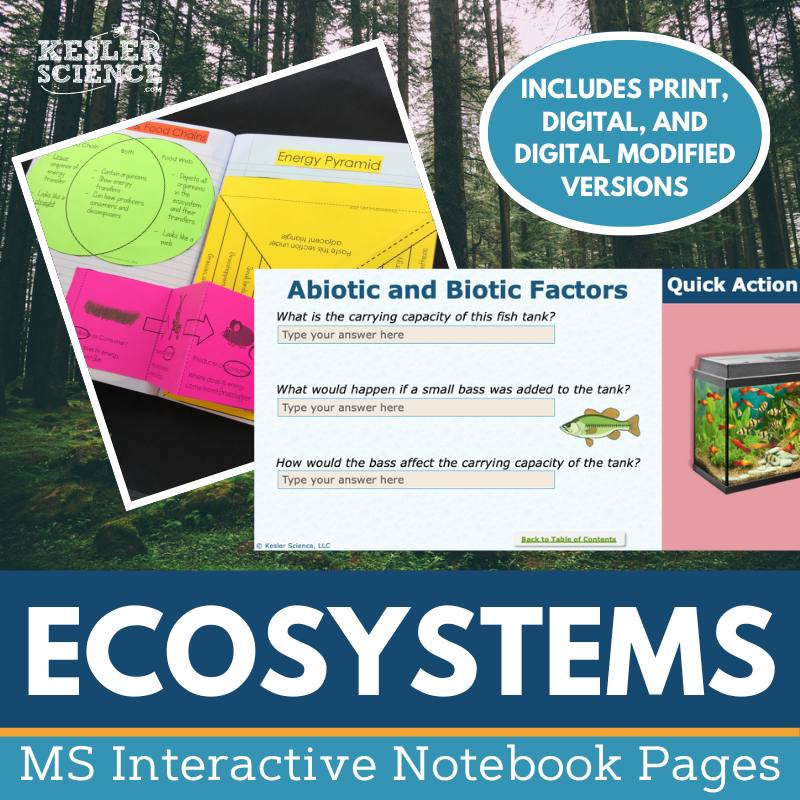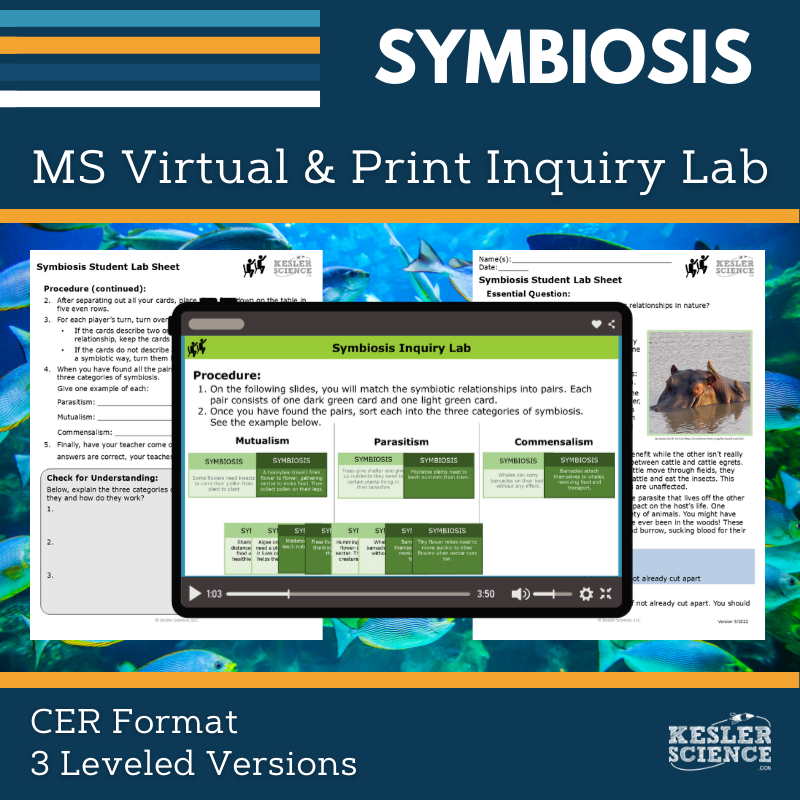Symbiosis Activities for Middle School Science
The Kesler Science Symbiosis resources provide a comprehensive, student-led approach to learning about symbiotic relationships, perfect for middle school science classrooms. The resources below will give students a comprehensive understanding of symbiosis. All of the following materials are also included in the Kesler Science Membership.
The Kesler Science Symbiosis Complete 5E Lesson makes teaching about symbiotic relationships easy and engaging. This multi-day lesson is designed for 6th-8th grade students, providing all the materials needed to explore essential questions like: What is a symbiotic relationship? What is the difference between mutualism, commensalism, and parasitism? Through differentiated, student-led activities, students will deepen their understanding with minimal prep for the teacher.
The lesson follows the 5E Model, covering Engagement, Exploration, Explanation, Elaboration, and Evaluation. In the Exploration phase, students work through nine differentiated stations, where they engage with multimedia resources, such as hands-on demos, readings, and videos. Output stations allow students to demonstrate their understanding through creative tasks like sorting, sketching, and writing.
The lesson also includes editable PowerPoints, interactive notebooks, and assessment tools to ensure students can showcase their learning in various formats. With options for both in-person and virtual learning, this resource supports all learners and provides enrichment activities like the "Challenge It!" station for advanced students.
The Kesler Science Symbiosis Complete 5E Lesson makes teaching about symbiotic relationships easy and engaging. This multi-day lesson is designed for 6th-8th grade students, providing all the materials needed to explore essential questions like: What is a symbiotic relationship? What is the difference between mutualism, commensalism, and parasitism? Through differentiated, student-led activities, students will deepen their understanding with minimal prep for the teacher.
The lesson follows the 5E Model, covering Engagement, Exploration, Explanation, Elaboration, and Evaluation. In the Exploration phase, students work through nine differentiated stations, where they engage with multimedia resources, such as hands-on demos, readings, and videos. Output stations allow students to demonstrate their understanding through creative tasks like sorting, sketching, and writing.
The lesson also includes editable PowerPoints, interactive notebooks, and assessment tools to ensure students can showcase their learning in various formats. With options for both in-person and virtual learning, this resource supports all learners and provides enrichment activities like the "Challenge It!" station for advanced students.
The Kesler Science Symbiosis Station Lab offers a modular, student-led approach to learning about symbiotic relationships in ecosystems. Middle school students explore the different types of symbiosis through eight differentiated stations, allowing for independent or small group work. With minimal prep, teachers facilitate the learning process while students take charge of their exploration.
The stations are divided into input and output activities. At input stations like "Explore It!" and "Watch It!" students engage with hands-on demos, readings, and videos. Output stations like "Organize It!" and "Write It!" give students the opportunity to apply their understanding through creative projects, written responses, and task cards.
The station lab also features a "Challenge It!" bonus station for advanced learners and early finishers, offering enrichment activities to deepen their understanding. Suitable for both in-person and virtual learning, this resource includes all necessary materials, including signage and task cards, ensuring a seamless learning experience across different environments.
The Kesler Science Symbiosis Station Lab offers a modular, student-led approach to learning about symbiotic relationships in ecosystems. Middle school students explore the different types of symbiosis through eight differentiated stations, allowing for independent or small group work. With minimal prep, teachers facilitate the learning process while students take charge of their exploration.
The stations are divided into input and output activities. At input stations like "Explore It!" and "Watch It!" students engage with hands-on demos, readings, and videos. Output stations like "Organize It!" and "Write It!" give students the opportunity to apply their understanding through creative projects, written responses, and task cards.
The station lab also features a "Challenge It!" bonus station for advanced learners and early finishers, offering enrichment activities to deepen their understanding. Suitable for both in-person and virtual learning, this resource includes all necessary materials, including signage and task cards, ensuring a seamless learning experience across different environments.
The Kesler Science Symbiosis Student Choice Projects allow middle school students to select a project that suits their preferred output style. With nine project options and a “design your own” choice, students can showcase their learning in creative ways. The grading rubric is flexible, allowing teachers, peers, or students themselves to assess the projects.
These dynamic, multimodal projects offer flexibility for teachers and students, with the option to modify the rubric as needed. Whether for remediation or challenge, the projects cater to various student needs and encourage personalized learning. Differentiated versions of the project page ensure that every student can succeed.
The projects require standard classroom supplies such as paper, markers, and scissors, with some projects allowing for digital completion. For hands-on activities, crafting supplies may be useful. This resource is designed to support a range of learners and project preferences.
The Kesler Science Symbiosis Student Choice Projects allow middle school students to select a project that suits their preferred output style. With nine project options and a “design your own” choice, students can showcase their learning in creative ways. The grading rubric is flexible, allowing teachers, peers, or students themselves to assess the projects.
These dynamic, multimodal projects offer flexibility for teachers and students, with the option to modify the rubric as needed. Whether for remediation or challenge, the projects cater to various student needs and encourage personalized learning. Differentiated versions of the project page ensure that every student can succeed.
The projects require standard classroom supplies such as paper, markers, and scissors, with some projects allowing for digital completion. For hands-on activities, crafting supplies may be useful. This resource is designed to support a range of learners and project preferences.
The Kesler Science Ecosystems Interactive Notebook Bundle provides an engaging and interactive way for students to explore key ecosystems concepts. Designed for flexibility, the resource includes both print and digital versions, making it suitable for traditional classrooms, 1:1 environments, and distance learning settings.
The bundle covers a wide range of topics, including biotic and abiotic factors, biomes, food webs, symbiosis, and the nitrogen and carbon cycles. Digital features include a unique interactive notebook PowerPoint, editable Google Slides compatibility, reflection pages, and modified versions for students with accommodations. The paper version includes blank and pre-filled templates, complete with color examples to guide students and teachers.
This resource supports differentiated instruction and accommodates all learners with thoughtfully designed templates and modifications. Whether in person or online, the Ecosystems Interactive Notebook promotes active learning, critical thinking, and scientific literacy.
The Kesler Science Ecosystems Interactive Notebook Bundle provides an engaging and interactive way for students to explore key ecosystems concepts. Designed for flexibility, the resource includes both print and digital versions, making it suitable for traditional classrooms, 1:1 environments, and distance learning settings.
The bundle covers a wide range of topics, including biotic and abiotic factors, biomes, food webs, symbiosis, and the nitrogen and carbon cycles. Digital features include a unique interactive notebook PowerPoint, editable Google Slides compatibility, reflection pages, and modified versions for students with accommodations. The paper version includes blank and pre-filled templates, complete with color examples to guide students and teachers.
This resource supports differentiated instruction and accommodates all learners with thoughtfully designed templates and modifications. Whether in person or online, the Ecosystems Interactive Notebook promotes active learning, critical thinking, and scientific literacy.
The Kesler Science Symbiotic Relationships Inquiry Lab engages students with either a hands-on card-matching game or an interactive digital version that includes a video demonstration. Both versions guide students through identifying and analyzing different types of symbiotic relationships found in nature. Each format includes comprehension questions, C.E.R. (Claim-Evidence-Reasoning) prompts, and a final reflection section to deepen understanding.
This lab includes three differentiated versions—Dependent, Modified, and Independent—to support learners at various levels. The Dependent version includes structured guidance and inquiry questions, the Modified version offers simplified tasks and sentence stems, and the Independent version encourages advanced learners to lead their own investigation by creating some of their own cards.
Teachers receive editable PowerPoints, answer keys, teacher guides, and Google Slides-compatible files, ensuring maximum flexibility for both digital and print formats. With built-in differentiation, clear instructions, and engaging resources, this lab makes it easy to explore the essential question, "What are the different kinds of symbiotic relationships in nature?"
The Kesler Science Symbiotic Relationships Inquiry Lab engages students with either a hands-on card-matching game or an interactive digital version that includes a video demonstration. Both versions guide students through identifying and analyzing different types of symbiotic relationships found in nature. Each format includes comprehension questions, C.E.R. (Claim-Evidence-Reasoning) prompts, and a final reflection section to deepen understanding.
This lab includes three differentiated versions—Dependent, Modified, and Independent—to support learners at various levels. The Dependent version includes structured guidance and inquiry questions, the Modified version offers simplified tasks and sentence stems, and the Independent version encourages advanced learners to lead their own investigation by creating some of their own cards.
Teachers receive editable PowerPoints, answer keys, teacher guides, and Google Slides-compatible files, ensuring maximum flexibility for both digital and print formats. With built-in differentiation, clear instructions, and engaging resources, this lab makes it easy to explore the essential question "What are the different kinds of symbiotic relationships in nature?"
Year-Round Resources
These year-round activities will increase your students' understanding of many middle school science topics. All of these activities are also included in the Kesler Science Membership.
Visual Data & Graphing
You're not alone if your students struggle with understanding graphs, charts, and tables. It's a skill that takes an enormous amount of practice. This resource will help students build a strong foundation in analyzing data and creating their own data visualizations.
Bell Ringers and Warm-Ups
These middle school science bell ringers are an excellent way to engage your students as soon as they walk into your classroom. This comprehensive FULL YEAR resource includes everything you need to start off each science class with an interesting warm-up activity.
Review Board Games
Each game board has been carefully designed to keep students engaged. There are 10 different action spaces on each board and dozens of question cards. All of the actions are related to science concepts and keep the students motivated throughout the game.
Each game is ready to play. Simply print out the board and the cards and let the students enjoy reviewing nine different units.
Essential Questions
Below are the essential questions associated with the lessons and activities included in this unit. This topic is only one of more than 100 middle school science topics included in the Kesler Science Membership.
-
What is a symbiotic relationship?
-
What is the difference between mutualism, commensalism, and parasitism?
-
What are examples of each?
Kesler Science Membership
Imagine never having to search for another middle school science lesson again. The membership gives you access to ALL of the Kesler Science products in one place (Yes, including everything above).
Say goodbye to long hours of lesson prep.

